优质课Festival around the world --writing
- 格式:ppt
- 大小:4.02 MB
- 文档页数:16
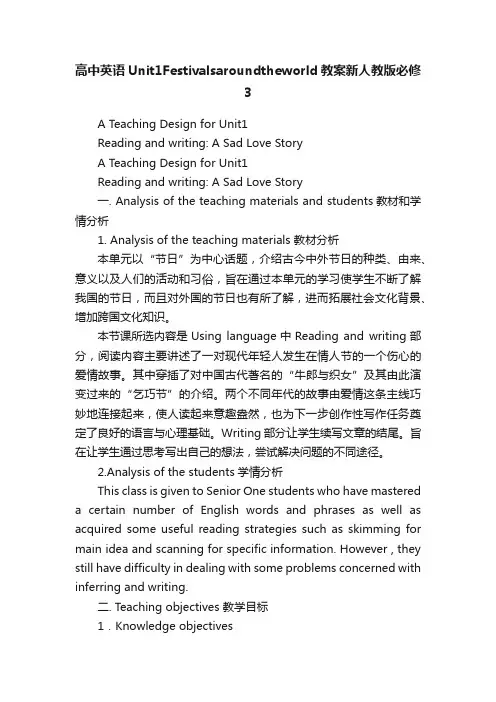
高中英语Unit1Festivalsaroundtheworld教案新人教版必修3A Teaching Design for Unit1Reading and writing: A Sad Love StoryA Teaching Design for Unit1Reading and writing: A Sad Love Story一. Analysis of the teaching materials and students教材和学情分析1. Analysis of the teaching materials 教材分析本单元以“节日”为中心话题,介绍古今中外节日的种类、由来、意义以及人们的活动和习俗,旨在通过本单元的学习使学生不断了解我国的节日,而且对外国的节日也有所了解,进而拓展社会文化背景、增加跨国文化知识。
本节课所选内容是Using language中Reading and writing部分,阅读内容主要讲述了一对现代年轻人发生在情人节的一个伤心的爱情故事。
其中穿插了对中国古代著名的“牛郎与织女”及其由此演变过来的“乞巧节”的介绍。
两个不同年代的故事由爱情这条主线巧妙地连接起来,使人读起来意趣盎然,也为下一步创作性写作任务奠定了良好的语言与心理基础。
Writing部分让学生续写文章的结尾。
旨在让学生通过思考写出自己的想法,尝试解决问题的不同途径。
2.Analysis of the students学情分析This class is given to Senior One students who have mastered a certain number of English words and phrases as well as acquired some useful reading strategies such as skimming for main idea and scanning for specific information. However , they still have difficulty in dealing with some problems concerned with inferring and writing.二. Teaching objectives 教学目标1.Knowledge objectives(1).The students will be able to learn some new vocabulary in the passage: apologize/drown/sadness/obvious/wipe/weave/weep/forgive/t urnup/keep one’s word/hold one’s breath/set off/remind…of.(2).The students will be able to read and understand the story A Sad Love Story. 2.Ability objectives(1). The students will be able to improve their reading abilities and skills likescanning, skimming and writing abilities.(2). The students will be able to guess the meanings of the new words and phrases. 3.Emotional objectives(1)The students’ sense of cross-cultural communication will be greatly aroused. (2)The students’ sense of cooperation will be developed and they will be able to experience the pleasure of cooperation and success.三.Teaching important points and difficult points 教学重点与难点1.Teaching important points 教学重点(1)How to improve the students’ reading abilit ies and skills(2)How to help the students understand different festivals about a love story and how to write a different ending for the story.2.Teaching difficult points 教学难点(1)How to help the students to write the ending for the story.(2)How to help the students learn to use different reading skills四.Teaching practice教学实践1. The idea of my teaching design教学设计思路本节所讲内容是本单元的Reading and writing部分。
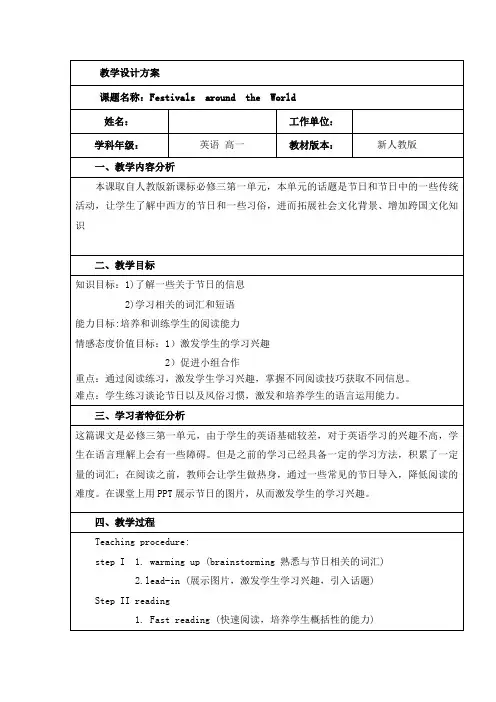
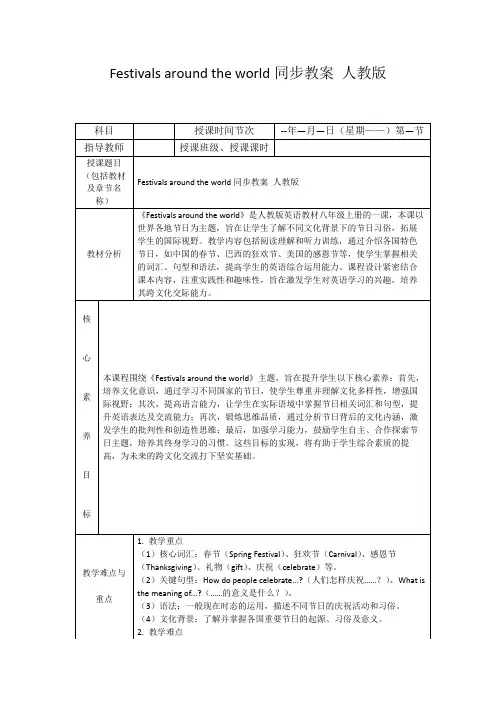
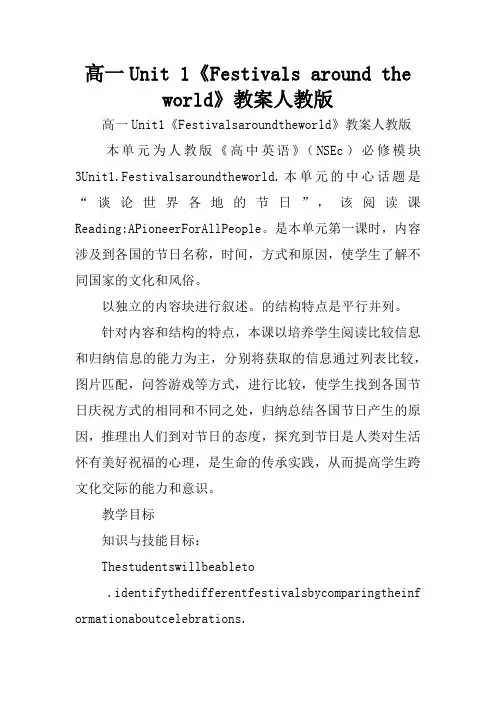
高一Unit 1《Festivals around theworld》教案人教版高一Unit1《Festivalsaroundtheworld》教案人教版本单元为人教版《高中英语》(NSEc)必修模块3Unit1.Festivalsaroundtheworld.本单元的中心话题是“谈论世界各地的节日”,该阅读课Reading:APioneerForAllPeople。
是本单元第一课时,内容涉及到各国的节日名称,时间,方式和原因,使学生了解不同国家的文化和风俗。
以独立的内容块进行叙述。
的结构特点是平行并列。
针对内容和结构的特点,本课以培养学生阅读比较信息和归纳信息的能力为主,分别将获取的信息通过列表比较,图片匹配,问答游戏等方式,进行比较,使学生找到各国节日庆祝方式的相同和不同之处,归纳总结各国节日产生的原因,推理出人们到对节日的态度,探究到节日是人类对生活怀有美好祝福的心理,是生命的传承实践,从而提高学生跨文化交际的能力和意识。
教学目标知识与技能目标:Thestudentswillbeableto.identifythedifferentfestivalsbycomparingtheinf ormationaboutcelebrations.2.explainthereasonwhythefestivalscomeintobeingbyfin dingoutthesimilaritiesanddifferences.3.describetheirfavoritefestivalsbyusingthelanguagef romthetext.教学重点和难点)为全体学生进行有效性阅读策略的指导,包括语篇分析、猜测词义,逻辑推理、归纳概括等技巧。
2)通过比较信息,归纳总结各国节日产生的原因,推理出人们到对节日的态度和节日的意义。
教学过程教学步骤教学活动设计意图Pre-reading:Step1.Brainstorm:motivatetheSsbyaskingsomequestions.Q1:Doyouanyfestivalsaroundtheworld?Step2.matchthecelebrationwiththefestivals.Q2:DoyouknowhowpeoplecelebratetheseFestivals?Doaquiz.Step2.DiscussionSsdiscussthefollowingquestionsQ1:Howdotheycomeintobeing?Q2:whatdotheyhaveincommon?Andwhataretheredifference amongthem?问题引发了学生的思考,调动学生的已知,将学生的思维活动引导到课文主题上来。
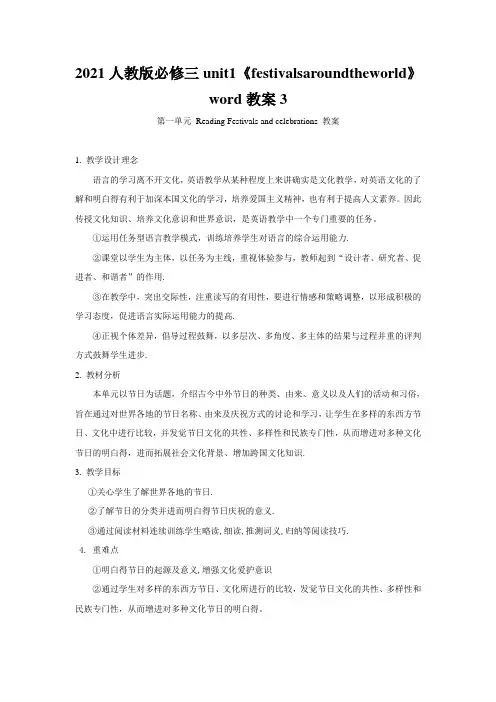
2021人教版必修三unit1《festivalsaroundtheworld》word教案3第一单元Reading Festivals and celebrations 教案1. 教学设计理念语言的学习离不开文化,英语教学从某种程度上来讲确实是文化教学,对英语文化的了解和明白得有利于加深本国文化的学习,培养爱国主义精神,也有利于提高人文素养。
因此传授文化知识、培养文化意识和世界意识,是英语教学中一个专门重要的任务。
①运用任务型语言教学模式,训练培养学生对语言的综合运用能力.②课堂以学生为主体,以任务为主线,重视体验参与,教师起到“设计者、研究者、促进者、和谐者”的作用.③在教学中,突出交际性,注重读写的有用性,要进行情感和策略调整,以形成积极的学习态度,促进语言实际运用能力的提高.④正视个体差异,倡导过程鼓舞,以多层次、多角度、多主体的结果与过程并重的评判方式鼓舞学生进步.2. 教材分析本单元以节日为话题,介绍古今中外节日的种类、由来、意义以及人们的活动和习俗,旨在通过对世界各地的节日名称、由来及庆祝方式的讨论和学习,让学生在多样的东西方节日、文化中进行比较,并发觉节日文化的共性、多样性和民族专门性,从而增进对多种文化节日的明白得,进而拓展社会文化背景、增加跨国文化知识.3. 教学目标①关心学生了解世界各地的节日.②了解节日的分类并进而明白得节日庆祝的意义.③通过阅读材料连续训练学生略读,细读,推测词义,归纳等阅读技巧.4. 重难点①明白得节日的起源及意义,增强文化爱护意识②通过学生对多样的东西方节日、文化所进行的比较,发觉节日文化的共性、多样性和民族专门性,从而增进对多种文化节日的明白得。
5. 教学步骤Unit 1 Festivals around the worldLearning aims : 1.learn about festivals around the world.2. learn about the kinds of festivals and the reason for celebrating them.3. train reading skills such as skimming and summarizing.Difficult points : the reason for peopke’s celebrating festivalsStep 1 Warming up1.What other traditional festivals in China do you know ?______________________________________________________________2.What festivals of foreign countries do you know?______________________________________________________________ Step 2 ReadingI.Fasting reading fill in the chartII.Careful readingTask 1 main ideas of each paragraph 1).2). Festivals to Honour People (Match the person with the festival.)1. Qu Y uan a. the Dragon Boat Festival2. Christopher Columbus b. an Indian national festival on Oct. 23. Mohandas Gandhi c. Columbus Day3). Harvest Festivals (Choose the best answer.)Many activities can be held in harvest festivals EXCEPT that people ___.A. get together to have mealsB. decorate houses to admire the moonC. win awards for their farm produceD. enjoy mooncakes4.)Task 2 True or False1. The ancient people needn’t worry about their food.2. Halloween used to be a festival to honor the dead.3. Qu Y uan was a great poet who people honor a lot in China.4. Mid-autumn Festival is held to celebrate the end of autumn.5. Easter celebrates the birth of Jesus.Task 3 Answer the questions1.What are festivals of the dead usually for?2. What makes autumn festivals happy events?3. What do people usually do at spring festivals?4. What is one important reason to have festivals and celebrations?III. Free talkingWhat do most festivals seem to have in common ?Step 3 Discussing◆What is your favourite festival? Why?◆When is it? What is the festival about?◆How long can we have for holiday? What do we usually do in the festival? Step 4 HomeworkWrite a short passage about your favorite festival。
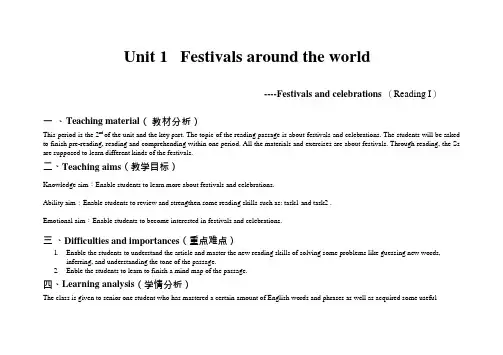
Unit 1 Festivals around the world----Festivals and celebrations (Reading I)一、Teaching material(教材分析)This period is the 2nd of the unit and the key part. The topic of the reading passage is about festivals and celebrations. The students will be asked to finish pre-reading, reading and comprehending within one period. All the materials and exercises are about festivals. Through reading, the Ss are supposed to learn different kinds of the festivals.二、Teaching aims(教学目标)Knowledge aim:Enable students to learn more about festivals and celebrations.Ability aim:Enable students to review and strengthen some reading skills such as: task1 and task2 .Emotional aim:Enable students to become interested in festivals and celebrations.三、Difficulties and importances(重点难点)1.Enable the students to understand the article and master the new reading skills of solving some problems like guessing new words,inferring, and understanding the tone of the passage.2.Enble the students to learn to finish a mind map of the passage.四、Learning analysis(学情分析)The class is given to senior one student who has mastered a certain amount of English words and phrases as well as acquired some usefulreading strategies. However they still have difficulty in dealing with some problems concerned with guessing new words, inferring, and understanding the tone of the passage.五、Teaching methods(教学方法)Co-operative learning task-based discussion六、Teaching aids(教学手段)利用多媒体一体机、网络资源、自制音像等创设教学情景、问题情景,扩大教学容量,增强教学的趣味性和时效性.七、Teaching procedures 教学过程Step1:checking(检查)Ask the students to recite some sentences we have learned.(设计意图:巩固检查,加强学生的记忆能力.)Step2:Pre-reading1.Play the games to guess what the video and the picture are about.2.Through some questions to lead into this passage.(Do you know what this is?Can you name some festivals? Any other festivals?---)What is festivals and celebrations?(设计意图:通过图片、视频展现对节日的介绍,以及问题引领,让学生更直观的了解什么是节日,旨在导入新课,提高学生的兴趣.)Step3:Learning aims(学习目标)1.To learn the passage by skimming, scanning and careful reading (reading skills).2.To learn something about different festivals and celebrations around the world.3.to learn to deal with the problems in groups.(设计意图:旨在明确目标,当堂达标.)Step4:Reading(阅读)Task1:Fast reading:The passage is mainly about different and the of celebrations and also the why people celebrate them all over the world.Task2:Enjoy the video 、listen carefully and finish Ex.1Task :Enjoy the video and fill in the chart according to the text.(设计意图:播放课文视频,以优美的声音和图片介绍本节课,提高学生的兴趣. 通过本题,旨在培养学生快速阅读课文的能力.)Task3:Careful readingTo know some details about the passage. Pay attention to the key verbs . Then describe it with them.How do people celebrate each festival?Para2. Festivals of the Dead.1.Key verbs:2. DescriptionPeople are going to clean the graves and light incense in memory of their ancestors.They also light lamps and play music because they think that this will lead the ancestors back to the earth.-------Para3. Festivals to Honour PeopleMatch the festivals with the proper people.Para4. Harvest FestivalsAre harvest festivals always happy events?Harvest festivals are always happy events because people are (thankful) that food is gatheredfor the winter and (农活) is over .How do people celebrate the festivals (key verbs)?Para5. Spring FestivalsWhat do people usually do at Spring Festival?Chinese People usually eat and give children . There are and ,and families celebrate the together.Some Western countries have ,including and dances in the streets , loud music and colorful.(设计意图:细读全文,提高学生的兴趣. 通过本题,旨在培养学生提炼细节,掌握关键词,提高阅读课文的能力.)Step4:Deeply thinkingWhat did people celebrate in the ancient times?What origins do the today’s festivals have?The differences between ancient times and today.Dong Ping Rape Flowers Festival (东平油菜花节)(设计意图:发散思维,不仅仅限于课本,还可以跳出课本,拓展自己的视野,各抒己见,通过本题,旨在培养学生语言表达的能力.)Step5:DiscussionIn groups to talk about the questions about Traditional festivals and Western festivals.Should we, Chinese students, celebrate western festivals like Christmas?AnswersYes NO(设计意图:小组讨论,合作学习,旨在培养学生对我们祖国河山的热爱和传统文化知识的传承,摈弃外国洋节,端正自己的价值观、人生观.)Step6:SummaryThere are all kinds of festivals and around the world, which are held for different reasons. The were mainly held at three times a year--- the end of the cold winter, planting in spring and harvest in autumn.Some festivals are held to the dead or satisfy and the in case they might , while other festivals are held to honor famous people or the gods, such as and Columbus Day. (设计意图:总结知识,当堂达标。
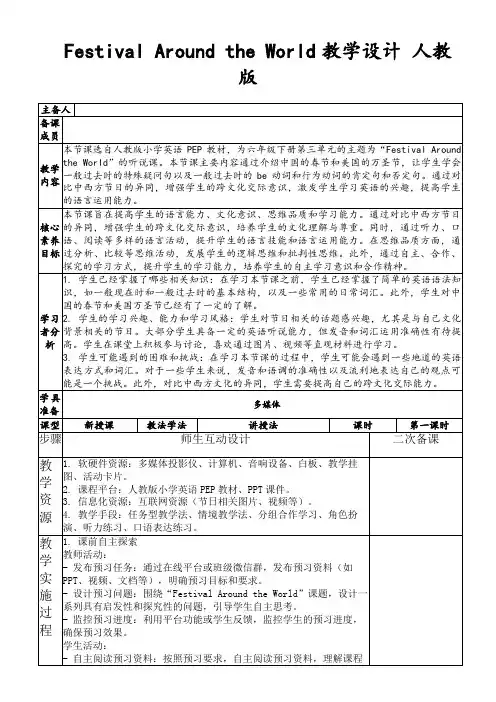
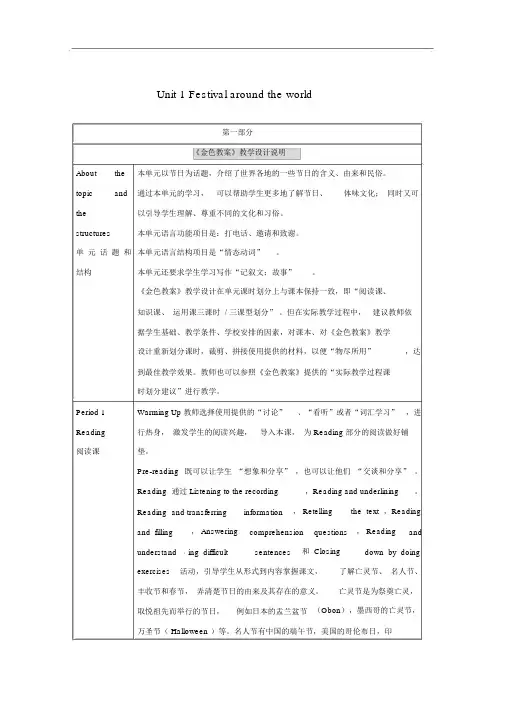
Unit 1 Festival around the world第一部分《金色教案》教学设计说明About the本单元以节日为话题,介绍了世界各地的一些节日的含义、由来和民俗。
topic and通过本单元的学习,可以帮助学生更多地了解节日、体味文化;同时又可the以引导学生理解、尊重不同的文化和习俗。
structures本单元语言功能项目是:打电话、邀请和致谢。
单元话题和本单元语言结构项目是“情态动词” 。
结构本单元还要求学生学习写作“记叙文:故事”。
《金色教案》教学设计在单元课时划分上与课本保持一致,即“阅读课、知识课、运用课三课时 / 三课型划分”。
但在实际教学过程中,建议教师依据学生基础、教学条件、学校安排的因素,对课本、对《金色教案》教学设计重新划分课时,裁剪、拼接使用提供的材料,以便“物尽所用”,达到最佳教学效果。
教师也可以参照《金色教案》提供的“实际教学过程课时划分建议”进行教学。
Period 1Warming Up 教师选择使用提供的“讨论”、“看听”或者“词汇学习” ,进Reading行热身,激发学生的阅读兴趣,导入本课,为 Reading 部分的阅读做好铺阅读课垫。
Pre-reading既可以让学生“想象和分享” ,也可以让他们“交谈和分享” 。
Reading通过 Listening to the recording,Reading and underlining。
Reading and transferring information, Retelling the text ,Readingand filling, Answering comprehension questions, Reading andunderstand ing difficult sentences和 Closing down by doingexercises活动,引导学生从形式到内容掌握课文,了解亡灵节、名人节、丰收节和春节,弄清楚节日的由来及其存在的意义。
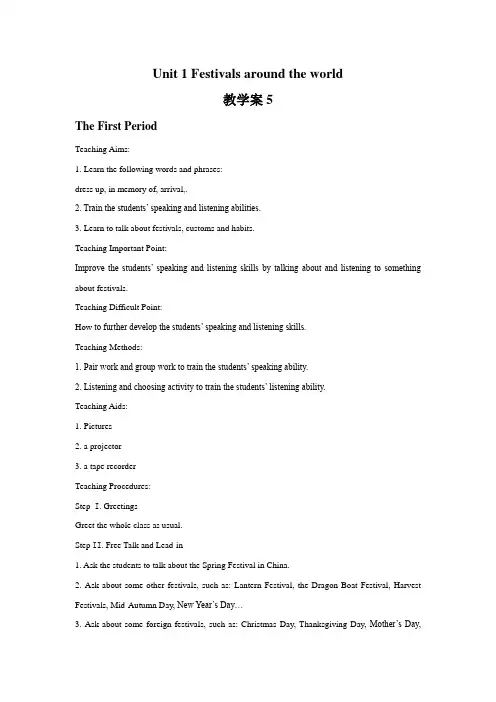
Unit 1 Festivals around the world教学案5The First PeriodTeaching Aims:1. Learn the following words and phrases:dress up, in memory of, arrival,.2. Train the students’ speaking and listening abilities.3. Learn to talk about festivals, customs and habits.Teaching Important Point:Improve the students’ speaking and listening skills by talking about and listening to something about festivals.Teaching Difficult Point:How to further develop the students’ speaking and listening skills.Teaching Methods:1. Pair work and group work to train the students’ speaking ability.2. Listening and choosing activity to train the students’ listening ability.Teaching Aids:1. Pictures2. a projector3. a tape recorderTeaching Procedures:Step I. GreetingsGreet the whole class as usual.Step II. Free Talk and Lead-in1. Ask the students to talk about the Spring Festival in China.2. Ask about some other festivals, such as: Lantern Festival, the Dragon Boat Festival, Harvest Festivals, Mid-Autumn Day, New Year’s Day…3. Ask about some foreign festivals, such as: Christmas Day, Thanksgiving Day, Mother’s Day,April Fool’s Day, Valentine’s Day…Step Ⅲ. Warming up1.Look at the pictures and discuss the three questions.⑴. Do you know the names of the festivals?⑵. Do you know which countries the festivals come from?⑶. What are the people in the pictures doing? Why are they doing this?2. Ask the students to think of a Chinese festival and a foreign festival, and then work in pairs to compare them..StepⅣ. Listening1. Do a listening and choosing exercise about the following three festivals: Mardi Gras, Ramadan and Easter.2. Ask the students to work together to describe one of their favorite festivals.Step Ⅴ. Speaking1. Ask the students if they would like a new holiday, and ask them to decide what a new holiday should be about.2. After the students prepare for a while, teacher asks some students to talk about their new holiday separately.Step Ⅵ. Summary and Homework1. Ask the students to remember the festival and learn to use them..2. Try to collect more information about festivals and prepare for next part.The Second PeriodTeaching Aims:1. Learn and master the following words: feast, ancestor, awards, gathered, look forward to2. Train the students’ reading ability.3. Let the students learn about the relation between festivals and history and culture.Teaching Important Points:1. Improve t he students’ reading ability.2. Help the students learn about foreign history and culture by reading about festivals.Teaching Difficult Point:How to help the students understand the passage exactly.Teaching Methods:1. Discussions before reading and after reading to make the students interested in what they will read and further understand what they have read.2. Fast reading and careful reading to understand the passage correctly.3. Pair or group work to make the students take an active part in the activities in class.Teaching Aids:1. a TV set and a VCD2. a projector3. a recorderTeaching Procedures:StepⅠ. GreetingsGreet the students as usual.StepⅡ. Discussion and Lead-in1. Watch a program about a festival.2. Ask the students to talk about the program.3. Ask the students to discuss the questions below.﹙four questions﹚4. Learn the new words in the passage.Step Ⅲ. Reading1. Ask the students to read the passage silently and quickly to get the general idea.2. Ask the students to answer some questions.﹙three questions﹚3. Re-read the passage carefully to further understand it. Then work in groups of four to discuss some questions.4. Read aloud the passage and try to understand it better.StepⅣ. Listening and ConsolidationAsk the students to listen to the tape and finish the “true” or “false” exercise on Page11.StepⅤ. Summary and HomeworkPreview next part— Language study.The Third PeriodTeaching Aims :1. Review the new words appearing in the last two periods.2. Learn to use the modal verbs — must, have to, have got to.Teaching Important Points:1. Learn to guess the missing word according to the given sentence.2. Master the modal verbs correctly.Teaching Difficult Point:How to use “must”, “have to”, “have got to” properly and how to use their negative forms correctly.Teaching Methods:1. Practice and consolidate the words learned in the last two periods.2. Giving examples to explain the difference between “must” and “have to” and the difference between “mustn’t” and “don’t have to”.3. Making sentences to consolidate the usages of the modal verbs.Teaching Aids:1. a projector2. some slides3. some picturesTeaching Procedures:StepⅠ. GreetingsGreet the whole class as usual.StepⅡ. Revision1. Ask the students to review something about Kwanzaa, such as the birth of it, the purpose of it, the way of celebrating it, and the seven principles of it.2. Ask students some questions about the passage.3. Find the right explanation for each of the words.﹙nation, faith, determination, purpose, generation, ancestor, peace trick﹚4. Word Study. Ask the students to choose the best word to fill in each blank.StepⅢ. Grammar1. Modal Verbs: must, have to, have got to.2. The negative forms of the modal verbs.3. Do the exercisesStepⅣ. PracticeDo the exercisesStepⅤ. Summary and Homework1. Review the contents in this class, paying attention to the differences between “must” and “have to” and the difference between “mustn’t” and “don’t have to”.2. Do more exercises to learn to use them properly.The Fourth PeriodTeaching Aims:1. Learn the following words and phrases: reminder, care about, respect, cycle, fool, play tricks on, take in, invitation2. Review the language points and modal verbs in this unit.3. Train the students’ integrating skills, especially writing skill.Teaching Important Points:1. Useful expressions: care about, play tricks on, take in2. Practice expressing and supporting an opinion.3. Write an invitation.Teaching Difficult Points:1. How to create a festival and describe it.2. How to write an invitation.Teaching Methods:1. Review method to consolidate the language points of this unit.2. Individual, pair or group work to finish the reading and writing tasks.Teaching Aids:1. a projector2. some slidesTeaching Procedures:StepⅠ. GreetingsGreet the whole class as usual.StepⅡ. Revision1. Review the usages of the modal verbs learned before.2. Read about some other festivals. Besides, ask the students to create a festival and then write an invitation to invite their guests to their festival.StepⅢ. Reading1. Read some information about each festival.2. Ask the students some questions about the festivals in the passage.﹙four questions﹚3. Learn some useful expression in the passage.﹙care about, play tricks on / play a trick on, take in﹚4. Give the students some more time to re-read the passage and discuss the questions after the passage with their partners, and then check them out.StepⅣ. Writing1. Ask the students to finish the contents mentioned on Page 8. Then write a short description of their own festival. At the end, tell their classmates about their festival.StepⅤ. Summary and Homework1. Practice reading and writing about festival.2. Learn more about festivals, customs and habits of foreign countries。
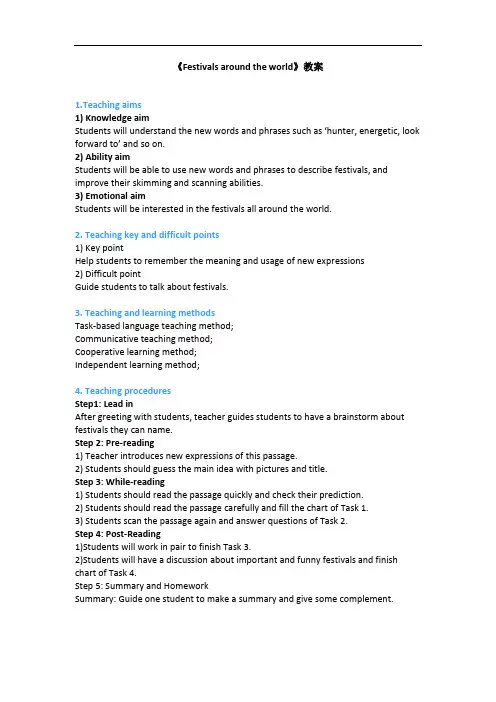
《Festivals around the world》教案1.Teaching aims1) Knowledge aimStudents will understand the new words and phrases such as ‘hunter, energetic, look forward to’ and so on.2) Ability aimStudents will be able to use new words and phrases to describe festivals, and improve their skimming and scanning abilities.3) Emotional aimStudents will be interested in the festivals all around the world.2. Teaching key and difficult points1) Key pointHelp students to remember the meaning and usage of new expressions2) Difficult pointGuide students to talk about festivals.3. Teaching and learning methodsTask-based language teaching method;Communicative teaching method;Cooperative learning method;Independent learning method;4. Teaching proceduresStep1: Lead inAfter greeting with students, teacher guides students to have a brainstorm about festivals they can name.Step 2: Pre-reading1) Teacher introduces new expressions of this passage.2) Students should guess the main idea with pictures and title.Step 3: While-reading1) Students should read the passage quickly and check their prediction.2) Students should read the passage carefully and fill the chart of Task 1.3) Students scan the passage again and answer questions of Task 2.Step 4: Post-Reading1)Students will work in pair to finish Task 3.2)Students will have a discussion about important and funny festivals and finish chart of Task 4.Step 5: Summary and HomeworkSummary: Guide one student to make a summary and give some complement.Homework: Students should write a short passage about the festival that they are familiar with. Surf on the internet to know some special and interesting foreign festivals.5. Blackboard design。
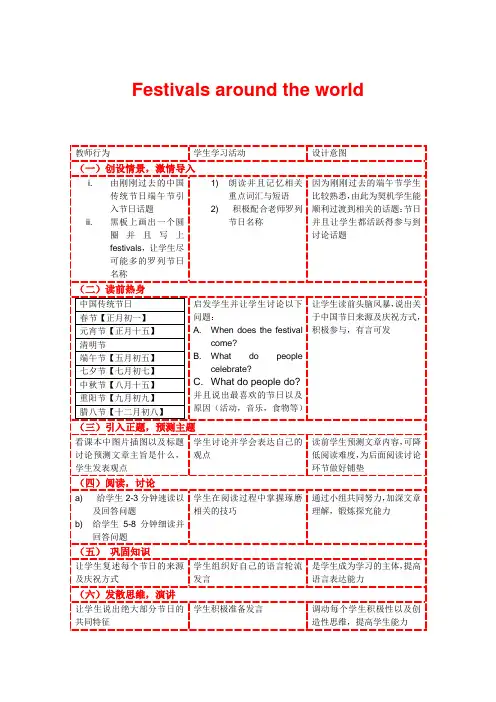
Festivals around the world教师行为 由刚刚过去的中国 传统节日端午节引 入节日话题 黑板上画出一个圆 圈 并 且 写 上 festivals,让学生尽 可能多的罗列节日 名称学生学习活动 朗读并且记忆相关 重点词汇与短语 积极配合老师罗列 节日名称设计意图 因为刚刚过去的端午节学生 比较熟悉, 由此为契机学生能 顺利过渡到相关的话题: 节日 并且让学生都活跃得参与到 讨论话题(一)创设情景,激情导入i. 1) 2)ii.(二)读前热身中国传统节日 春节【正月初一】 元宵节【正月十五】 清明节 端午节【五月初五】 七夕节【七月初七】 中秋节【八月十五】 重阳节【九月初九】 腊八节【十二月初八】 看课本中图片插图以及标题 讨论预测文章主旨是什么, 学生发表观点 启发学生并让学生讨论以下 问题: A. When does the festival come? B. What do people celebrate? 让学生读前头脑风暴, 说出关 于中国节日来源及庆祝方式, 积极参与,有言可发C. What do people do?并且说出最喜欢的节日以及 原因(活动,音乐,食物等)(三)引入正题,预测主题学生讨论并学会表达自己的 观点 读前学生预测文章内容, 可降 低阅读难度, 为后面阅读讨论 环节做好铺垫 通过小组共同努力, 加深文章 理解,锻炼探究能力(四)阅读,讨论a) b) 给学生 2-3 分钟速读以 及回答问题 给学生 5-8 分钟细读并 回答问题 学生在阅读过程中掌握琢磨 相关的技巧(五) 巩固知识让学生复述每个节日的来源 及庆祝方式 学生组织好自己的语言轮流 发言 学生积极准备发言 是学生成为学习的主体, 提高 语言表达能力 调动每个学生积极性以及创 造性思维,提高学生能力(六)发散思维,演讲让学生说出绝大部分节日的 共同特征(七)作业(一) 1 复习单词与短语 (二) 2 熟悉中外节日 学会应用 巩固提高。
Learning aims:教学设计1to recite the phrases in the textbook and translate the phrases2to write out the outline of the composition by discussing with other students 3 to translate some sentences by making use of the sentence structures and make our sentences longer4to finish a complete and fluent composition by adding some topic sentences and connective wordLearning difficulties:Making up sentences with sentence structures correctly and how to make the composition fluent and coherentTeaching methodsPPP (Presentation-Practice-Production)Communicative teaching 交际教学法Cooperative learning 合作学习Task-based teaching 任务型教学Teaching aids:Multimedia, blackboardTeaching procedure:Step one: Check the phrases about the festivals庆祝节日纪念给...提供聚在一起用...装饰打扮盼望玩得开心红包农历新年春节舞龙灯纪念某人v.【设计意图】通过复习短语,让学生在以下任务中能活学活用。
Step two : Review sentence structuresTask one : Read the sentences and identify(识别)their structure1)The most energetic and important festivals are the ones that look forward to the end of winter and to the coming of spring.2) China and Japan have mid-autumn festivals, when people admire themoon and in China, enjoy mooncakes.3)Some western countries have very exciting carnivals, which take place forty days before Easter.归类:Sentence structure(句型)one : 定语从句结构:主语+ 系动词+ the one(s) that主句+which/ when ... Imitation(模仿): 1)春节就是一个辞旧迎新的节日。
B3U1 Festivals around the World(教师案)Reading --A Sad Love Story使用说明: 学生在课前已经自主学习并完成了导学案。
课上针对性处理问题。
教学重点:合作探究,展示点评。
Part1【Learning aims】1.To skim and scan the text and know some basic information about the sad love story.2.To understand the six elements of narrative(记叙文六要素) clearly by self-study and cooperation.3.To know more about Qiqiao Festival and be more interested in our traditional culture.分层达标:1. A层高效完成三维目标,并能达到活学活用。
2. B层快速完成三维目标,尽可能达到活学活用。
3. C层基本完成三维目标,基本完成学案内容。
Part2【Problem inquiry】Task 1 Blank filling(框架引领)Task 2 Question answering(问题引领)1.What was Li Fang afraid that Hu Jin was doing?He was afraid that she was with her friend laughing at him.2. Why was the TV story what LiFang needed? (易错点)The TV story was a sad story about lost love—the same situation as LiFang.3. Why did people want the weather to be fine on Qiqiaojie?People wanted the weather to be fine so they can meet the one they love.4. How did Li Fang feel at the end of the story? Why? (发散点,批判性思维)He was worried because he has thrown away Hu Jin‘s Valentine‘s gif ts.其他参考:Sorry/ awkward/ speechless/sad/in relief…Part3【Free talk】Question: What more do you know about Qiqiao Festival?(自主发现,合作分享)_________________________________________________________________________________ _________________________________________________________________________________ _________________________________________________________________________________ _________________________________________________________________________________ _________________________________________________________________________________ _________________________________________________________________________________ ________________________________________________________________________________ Part4【Homework】Write your own ending to the story. (可操作,有抓手)●Think of how Li Fang will explain the flowers and chocolates are gone.●Think of what Hu Jin will say when she hears that news.●Think of an ending to the story that will solve the problem.Will Li Fang be happy or sad?_________________________________________________________________________________ _________________________________________________________________________________ _________________________________________________________________________________ _________________________________________________________________________________ _________________________________________________________________________________ ________________________________________________________________________________【My questions and my gains】B3U1 Festivals around the World(学生案)Reading --A Sad Love Story使用说明: 学生在课前已经自主学习并完成了导学案。
Unit 1Festivals around the world (教学设计)Speaking and writing(高中英语组罗洁)三维目标知识目标Review some words and expressions to describe festivals.能力目标1. Train students speaking ability, especially talking about festivals.2. Develop students’ writing abil ity to introduce some Chinese traditional festivals.情感目标1. Stimulate students’ love of national culture and customs.2.Train students’ ability to cooperate with others.教学重点1. Get knowledge of the outline of a passage.2. Get students to introduce some Chinese traditional festivals.教学难点How to develop students’ writing ability.教学方法:Task-based Teaching Method教具:Multimedia,a projector教学过程Step 1 Lead-in (2mins)设计意图:创设情景,激活思维。
通过歌曲,导入本堂课的话题:节日。
Play a short video entitled “恭喜发财”.T: Do you know what festival it is in the video?Step 2 Revision(5-8mins)设计意图:复习阅读篇章中节日相关知识,为speaking和writing环节做词汇、短语和背景知识的铺垫。